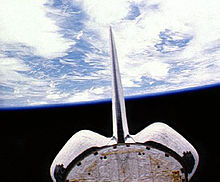| Mission type | Satellite inspection |
|---|---|
| Operator | US NRO |
| COSPAR ID | N/A |
| SATCAT no. | N/A |
| Spacecraft properties | |
| Bus | HS-376 |
| Manufacturer | Hughes |
| Launch mass | 1,300 kilograms (2,900 lb) |
| Start of mission | |
| Launch date | 15 November 1990, 23:48:13 (1990-11-15UTC23:48:13Z) UTC |
| Rocket | Space Shuttle Atlantis STS-38 / PAM-D |
| Launch site | Kennedy LC-39A |
| Orbital parameters | |
| Reference system | Geocentric |
| Regime | Near-geosynchronous |
Prowler was an American reconnaissance satellite launched aboard Space Shuttle Atlantis in 1990 to study Soviet satellites in geosynchronous orbit. The government of the United States has never acknowledged its existence, however it has been identified by amateur observers and through leaked information.
Spacecraft
Prowler was based on the HS-376 satellite bus, developed by Hughes. It had a mass of around 1,300 kilograms (2,900 lb) and carried modifications to reduce its visibility to ground-based observers and to radar. Following the satellite's retirement these modifications ceased to be effective, allowing it to be found by amateur observers.
Prowler was designed to maneuver to within a few meters of satellites in geosynchronous orbit. Its purpose was either to monitor them and return data about them, or to perform a signals intelligence mission such as intercepting communications between those satellites and the ground.
Launch
It seems that Prowler was deployed from Space Shuttle Atlantis during the STS-38 mission. STS-38 was launched from Launch Complex 39A at the Kennedy Space Center at 23:48:13 UTC on 15 November 1990. The mission was officially acknowledged to have deployed a single satellite, USA-67, which observers have since identified as part of the Satellite Data System. Prowler was deployed from Atlantis at around 04:37 UTC on 17 November 1990, and boosted into geosynchronous transfer orbit by a PAM-D upper stage. A second patch produced for the STS-38 mission showed a Shuttle orbiter in shadows above an illuminated orbiter; reversing the official mission patch; symbolizing the covert nature of the mission.
Identification

The nature of STS-38's payload was classified, but observers attempted to identify it. Since Prowler is by nature stealthy, USA-67 was initially believed to be the only satellite deployed. Thus, because of the single payload and two upper stages, USA-67 was believed to be a Magnum satellite, deployed via a two-stage Inertial Upper Stage (IUS). Photographs released from later in the STS-38 mission have shown that Atlantis was not carrying the adaptor necessary to deploy an IUS during STS-38.
In July 1998, amateur observers in Texas observed an unidentified object flashing in geosynchronous orbit. The object was subsequently lost, then was rediscovered in June 2000 when its flashes became brighter, some even visible with the naked eye. Following the 2000 observations amateur observers were still unable to identify the satellite, so began referring to it by the pseudo International Designator 2000-653A and pseudo Satellite Catalog Number 90007.
In 2004 NBC published an article containing details about Prowler and its mission.
In January 2010, amateur observer Ted Molczan cross-referenced data from the European Space Agency's Classification of Geosynchronous Objects survey with amateur observations of classified spacecraft, noting that an unidentified object designated UI.139 by the survey corresponded with observations of 2000-653A, and that its orbit was close to that of USA-67 - speculating that they may have been from the same launch. Based on this, Molczan conducted a more detailed investigation, and in 2011 published a paper identifying 2000-653A as Prowler.
See also
References
- ^ Molczan, Ted (21 January 2011). "Unknown GEO Object 2000-653A / 90007 Identified as Prowler" (PDF). Visual Satellite Observer's Home Page. Retrieved 25 February 2011.
- ^ Pike, John. "PROWLER". Federation of American Scientists. Retrieved 14 April 2013.
- ^ Krebs, Gunter. "Prowler". Gunter's Space Page. Retrieved 14 April 2013.
- ^ Windrem, Robert (9 December 2004). "What is America's top-secret spy program?". NBC News. Retrieved 14 April 2013.
- McDowell, Jonathan. "Launch Log". Jonathan's Space Page. Retrieved 25 February 2011.
- ^ Molczan, Ted (19 February 2011). "Evaluation of the Opportunity to Launch Prowler on STS 38" (PDF). Visual Satellite Observer's Home Page. Retrieved 25 February 2011.
- Guillemette, Roger; Day, Dwayne A. (25 August 2008). "Space Age Hieroglyphs". The Space Review. Retrieved 14 April 2013.
- McCants, Mike (31 July 1998). "Ed Cannon discovers another geosync flasher!". SeeSat-L. Retrieved 14 April 2013.
- Cannon, Ed (7 June 2000). "Two flashing geosynchs". SeeSat-L. Retrieved 14 April 2013.
- Cannon, Ed (8 June 2000). "TDF 2, "UNID A", and GSTAR 1". SeeSat-L. Retrieved 14 April 2013.
- Cannon, Ed (10 June 2000). "90007, 00653A now in mccants file". SeeSat-L. Retrieved 14 April 2013.
- Molczan, Ted (31 January 2010). "Identification of UI Objects in Classification of Geosynchronous Objects Issue 11" (PDF). Visual Satellite Observer's Home Page. Retrieved 14 April 2013.
| ← 1989Orbital launches in 19901991 → | |
|---|---|
| January | |
| February | |
| March | |
| April | |
| May | |
| June | |
| July | |
| August | |
| September | |
| October | |
| November | |
| December | |
| Launches are separated by dots ( • ), payloads by commas ( , ), multiple names for the same satellite by slashes ( / ). Crewed flights are underlined. Launch failures are marked with the † sign. Payloads deployed from other spacecraft are (enclosed in parentheses). | |